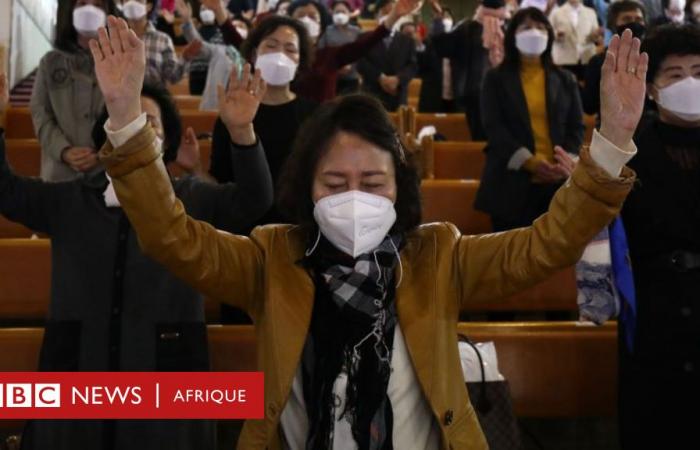Photo credit, Getty Images
“Joon” was raised in a Christian home in South Korea. But like many people in his home country, his religious beliefs today are very different from those he had as a child.
He now identifies as agnostic.
“I don’t know what exists. Maybe God exists, or maybe not exactly God – something supernatural,” he says by phone from Seoul.
Joon’s parents are still devout Christians and he says they would feel “deep sadness” if they found out he is no longer a believer. He doesn’t want to upset them and has asked to use a different name.
Joon’s experience mirrors the findings of a new study by the U.S. think tank Pew Research Center, which shows that East Asian countries have some of the highest rates in the world of people leaving or changing religions.
More than 10,000 people were surveyed about their beliefs, and many said they now have a different religious identity than the one they were raised with.
Photo credit, Getty Images
Hong Kong and South Korea top the list, with 53% of respondents in each country reporting a change in religious identity, including abandoning their religion altogether. In Taiwan, 42% of people have changed their religious beliefs, and in Japan, 32%.
Compare these figures to a 2017 survey in Europe, where no country recorded a religion change rate above 40%. Or in the United States, where data collected last year revealed that only 28% of adults no longer identify with the faith in which they were raised.
For Joon, the change in attitude coincided with his leaving home and exposure to new ideas. Growing up, his family “would wake up every morning around 6 o’clock, and everyone would read and share Bible verses.”
Every morning “was like a little church service,” he said.
He left home at 19 and began attending one of Seoul’s largest churches, a megachurch with thousands of members. It interpreted the Bible very literally, rejecting the theory of evolution, for example. This interpretation was incompatible with the scientific theory Joon had learned. His worldview changed in other ways, too.
“I think Christianity has a very clear sense of black and white, good and evil. But after observing society and meeting people from different backgrounds, I began to think that the world is made up of more gray areas.”
Joon says about half of his friends no longer believe in the faith they were raised in, especially those who were raised as Christians.
And it’s not just Christianity that is losing followers around it. 20% of people who were raised in Buddhism have now abandoned the faith. In Hong Kong and Japan, the figure is 17%.
Photo credit, Getty Images
Some people in the region are choosing to embrace a new religion. In South Korea, for example, 12% of Christians were new followers of the religion, compared to 5% for Buddhism.
In Hong Kong, new followers of Christianity and Buddhism were 9% and 4%, respectively.
However, the largest group among those changing their religious identity are those who do not identify with any religion, and this number is higher in East Asian countries than in other parts of the world.
37% of people in Hong Kong and 35% of people in South Korea said they had this experience, compared to 30% in Norway and 20% in the United States.
However, despite what appears to be increasing secularization, many of the region’s residents say they still participate in rituals and spiritual practices.
Across all countries surveyed, more than half of religiously unaffiliated people reported taking part in rituals honoring their ancestors in the past 12 months. Most people interviewed in the region say they believe in gods or invisible beings.
None of this comes as a surprise to religious studies expert Dr Se-Woong Koo. Speaking to the BBC from Seoul, he said the ability to appropriate elements from different religions is in keeping with the region’s history.
“Historically in East Asia there has been less emphasis on what might be called exclusive religious identity. If you were Taoist, that didn’t mean you couldn’t also be Buddhist or Confucian. These boundaries were much less clearly demarcated than in the West.
Photo credit, Getty Images
It was only in the 19th century, following increased contact and interaction with the West, that the concept of religion as we understand it today was introduced to East Asia.
According to Dr Koo, the possibility of having multiple identities and traditions has never really disappeared in the region.
He was also able to see it near his home. Dr. Koo says his mother changed her religious affiliation several times.
“Last weekend she registered as a member of a Catholic church in our area. And I was sure she was going to go there on Sunday.”
But she then told him she was actually going to “a prayer healing session” at a local evangelical church.
Dr. Koo asked, “What happened to the Catholic Church, Mom?” She replied that what she needed at that time was “more healing than anything else.”
Her mother had “wanted to go to the Catholic church because she was Catholic. But somehow, when it came to receiving a particular type of physical intervention that she felt she needed, she turns to another tradition.”






